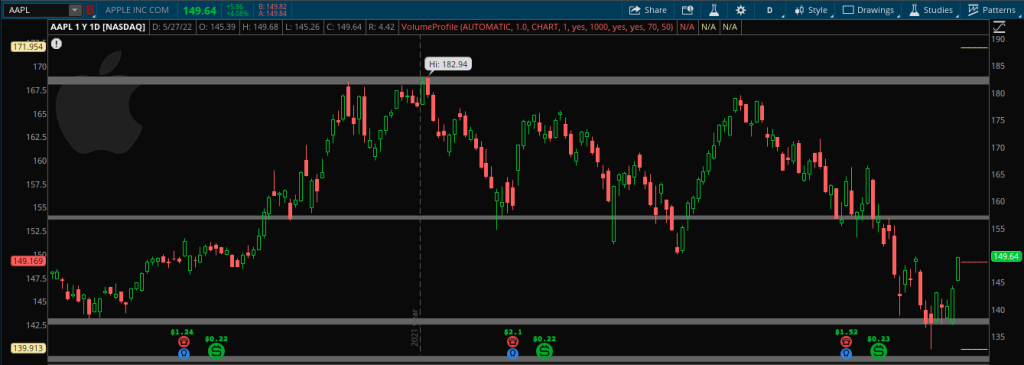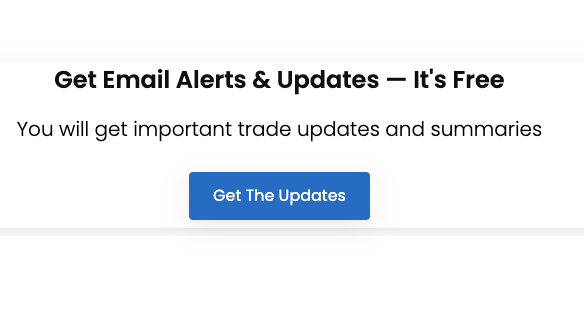There are three ways that you can go about setting stops on your Options trades and all three methods work well whether you are day trading or swing trading.
Method 1: Setting A Percentage (%) Stop Loss
This is basically when you take an option trade and set a stop loss on the contract price itself based on your risk appetite ( a level of risk that you can comfortably take) without giving too much consideration to the movement of the underlying stock.
For instance, lets say you bought the a AAPL JUN 150 Call @ 4.50 and decided that you cannot afford to lose more than 25% on this trade. You would then set a stop loss at 3.37 which would ensure ( all things being equal) that if the Option contract declined to 3.37, it would be automatically sold and you wouldn’t lose more than 1.12 on the trade.
To set this up, you would first place the following order:
Buy To Open 1 AAPL JUN 150.00 Call @ Limit 4.50
and then once you are filled you would go ahead and place the stop order:
Sell To Close 1 AAPL JUN 150.00 Call @ Stop 3.37, Limit 3.05
A Word About “Stop Orders” vs “Limit Orders” vs “Stop Limit Orders”
I know you are probably wondering why I would use “limit orders” on the trade entry instead of “stop limit orders” like I did on the exit.
Well, Limit Orders basically tell the market maker that you want to sell your contract if/when it gets to 3.37 or better. “Better” in this case ( since we are trying to prevent a big loss) means higher. So in other words, with the limit order you are saying “i want to sell this thing if it gets to 3.37. I will take a fill above 3.37 but I will not take a fill below 3.05”
A “Stop Order”, on the other hand, tells the market maker that you want to sell your contract at 3.37 once that price is reached. Period.
The important thing to note is that, with a “stop order”, once the set price is reached, the order becomes executable and can be filled at whatever the current market price is, which can give you a very bad fill in a fast moving market.
For instance, lets say the AAPL stock price is moving around wildly, and the Option Contracts are moving just as fast in response to high volume and volatility, and you place a stop order to get out of the AAPL 150.00 Calls at 3.37.
What is likely to happen here is that as soon as the price gets to 3.37 your order becomes executable. However, if there are many orders at that price lined up before your own, there is a strong chance ( given that the market is moving fast) that your order will not be filled immediately.
So a few seconds pass and you finally get filled at 2.90 because that is the current market price. You have just lost an additional .47 on the contract. So, please note that even though your order becomes executable once the price is reached, it doesn’t mean that it will be filled right away. It rarely ever will be. With a stop order you are effectively telling the market maker “ I want to sell this contract once the price reaches 3.37, even if I don’t get filled immediately at that price, I just want to get out of the trade once 3.37 is hit“. A stop order does not guarantee the best possible fill.
A stop Limit order is obviously a combination of both the limit and the stop order. With a stop limit order you are telling the market maker that ” I want to sell this contract at 3.37, and no lower, once the 3.37 level is hit. But do not sell unless I can get at least 6.05″.
The obvious downside is that you can get stuck in the trade if there is a gap situation in a very fast market, but compared to the others, it gives you more control over the fill and gives you a better chance to get a proper, cleaner fill.
Sorry about the digression. But I figured that if we were gonna talk about setting stops, we might as well clarify what they are.
Now back to the matter at hand.
Method 2: Setting A Stop Order Based On The Underlying Stock And The Option Greeks
This is the method that I use most often since I mostly swing trade. This method comprises of a few steps but it is really very simple and can be very effective if executed properly. Let’s take the same stock (AAPL) and Option contract ( JUN 150.00 Call) as an example and apply the following steps.
1. You want to take a look at the stock and see where it is trading relative to its nearest support level.
In this case AAPL closed the last session at 149.64 and the next level of significant support is at 144.39 and the next significant level below that is at 137.20.
Since we are swing trading, we have to assume ( and make room for) the possibility of a test of support. By setting our stops based on these support levels, we are ensuring that we will be out of the trade in the event that support is broken and the stock enters a downtrend.

2. Since we now know that the next level of significant support is about 5.25 from the current price we can go ahead and calculate an appropriate stop loss by using the Option Greeks.
NOTE: For those who do not know, the Greeks are nothing more than a couple of metrics/numbers that are used to price and gauge the risk profile an option. Don’t be intimidated by them.
For our purposes, we are primarily concerned with the Delta. The Delta is basically the rate at which an Option will change based on the change in the stock price and it is usually stated as a percentage. For instance, if a call option has a .50 Delta it basically means that for every 1.00 move in the price of the stock, the option will rise by .50 (theoretically).
This tutorial/guide is not for beginners so I am assuming you already know the basics. If not, you might want to check out a book called Trading Options Greeks which is by far the best book I ever read on Options trading. Moving on.
3. Now a quick look at the contract profile for the AAPL JUN 150.00 calls reveals that the Delta is currently .35. So this means, in theory, that for every 1.00 move in AAPL, the contract should move by .35 cents.
At this point, I have to remind you that time decay will also have an impact on how the option contract responds to movement in the stock price. So be mindful of that. But for this exercise, we will assume that only the Delta is important.
4. Now that we know that the Delta is .35 and we know that the next support level is at 144.39 we can do some calculations and get closer to an appropriate stop loss level for our trade.
So, since we have decided that we want to get out of the trade on a break below the 144.39 level, we are basically saying we are willing to give up/risk ~5.25 per share on the trade. With a delta of .35 that would be 1.83 on the JUN 150.00 Contract which is now trading at 4.50. Therefore the stop loss will be set at 2.67 initially.
Of course, this would mean a 59.3% loss if you got stopped out but, once again, we are just using this as an example for this tutorial. Besides, you would be expected to adjust your stop loss upwards to lock in gains along the way.
I know that was a lot to soak in at once. So let’s summarize the steps for method 2.
Step 1: Find out where the significant support level is on the underlying stock you are trading and select an Option contract. eg. We said the support level on AAPL was 144.39 and we decided we were trading the JUN 150.00 Calls which cost 4.50
Step 2: Find out what is the Delta for the option contract you are trading. eg. We said the Delta was .35
Step 3: Subtract the price at the support level from the current stock price. eg. 149.64-144.39 = 5.25
Step 4: Multiply the Delta by the result (amount of points/dollars) that you got from the subtraction in step 3. eg. 5.25 x .35= 1.83
Step 5: Subtract the result in step 4 above from the current option contract price. eg. 4.50-1.83= 2.67
Step 6: The result of the Subtraction in Step 5 above is where your stop loss on the Option Contract should be set. Finished.
By using the movement of the underlying stock and the Delta value of the option contract, you are putting your self in a better position to manage the trade as opposed to just setting a random % risk level on the Option Contract by itself ( as in Method 1).
This second method is not for everyone and it works best for larger accounts and real swing trading ( 1 week minimum holding period) and it works best in strong trending markets. Let me repeat: this method will work much better if you are buying calls in a strong upward trend or puts in a strong downward trend.
Method 3: Using The Stock’s Average True Range (ATR)
I am going to keep this as simple and straightforward as I can.
The ATR is a volatility measure and it basically tells you how much a stock tends to move up or down in any given day. So, for instance, if you see an ATR of 1.00 it simply means that the stock tends to move about 1.00 per day.
Now that could be 1.00 to the upside, 1.00 to the downside or .50 up and .50 down. You get the picture. Because ATR is a volatility tool and it is not static , the look back period is usually 20-30 days. So once you get the stock’s ATR you are going to use it to set your stops and targets on the Options.
In order to this we will need 4 things:
- The stock’s ATR
- The price of the underlying stock
- The size of the ATR based Stop
- The size of the ATR based Target ( if you choose to set a target)
- The Option Premium/Price
- And the Delta of the Option contract
We are going to continue to use Apple Inc (AAPL) in this example. This is how it is done:
Step 1: First you need to look up the stocks ATR. You can find this on just about any trading platform but just in case you have some issues getting this info, you can use finviz.com. Just type in the ticker symbol and you will get all the info you need here:

Step 2: Now you have to set your stops and targets based on the ATR. Now it is very important to remember that the stops and targets would have to be set on the underlying stock first. You are doing this to make sure you get the correct price levels from the chart so you can later use them to calculate your stops on the Options.
The standard is a 2:1 risk /reward ratio where you are essentially risking $1 in order to make $2. So you will be risking 1x ATR to make 2x ATR so, using the AAPL ATR of 6.07, that would mean you are risking 1×6.07 to make 2×6.07. Get it?
Let’s continue.
Step 3: Get the price of the underlying stock. So quickly scroll back up to the Daily chart of AAPL where we can clearly see that current price is 149.64
Step 4: Set the stop and the target on the underlying stock. To do this, you simply want to subtract the ATR from the current price to get the stop level and add the ATR to the current price to get the Target price on the underlying stock. So that would be:
Stop On Underlying Stock= Current Price Of Underlying – 1x ATR i.e 149.64 – 6.07 = 143.57
Target On Underlying Stock = Current Price Of Underlying + 2ATR i.e 149.64 + 12.14 = 161.78
Step 5: Select the Options contract. Let’s say that you decide to stick with the trade the JUN 2022 150.00 CALL. The premium/price of that Options contract is 4.50
Step 6. Get the Delta of the Options contract. Simply put, the Delta is the rate of change of the Option relative to the underlying stock so it basically gives you an idea of how much the Option will increase or decrease by with every 1.00 move in the underlying stock
Step 7: Do some simple calculations. Now that we have the 4 pieces of information that we need, we can go ahead and calculate our stops and targets on the Options. We are going to start by calculating the stop first, you always want to take care of the downside/risk first:
STOP = Premium – (Size of Stop x Delta) which is
4.50 -( 6.07 x .35) which is 4.50-(2.12) which = 2.38. So your stop on the Option will be 2.38
Now let’s do the Target:
TARGET = Premium + ( Size of Target x Delta) which is 4.50 + (12.14 x.35) which = 4.50 + (4.24) = 8.74. So your target on the Option will be 8.74
Remember to like and share this info if you found it to be useful.


